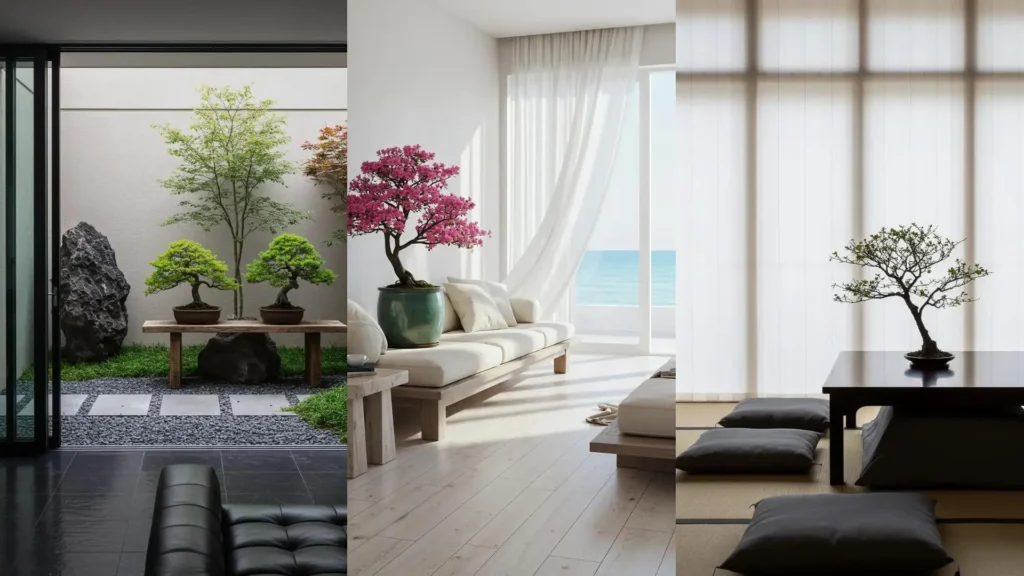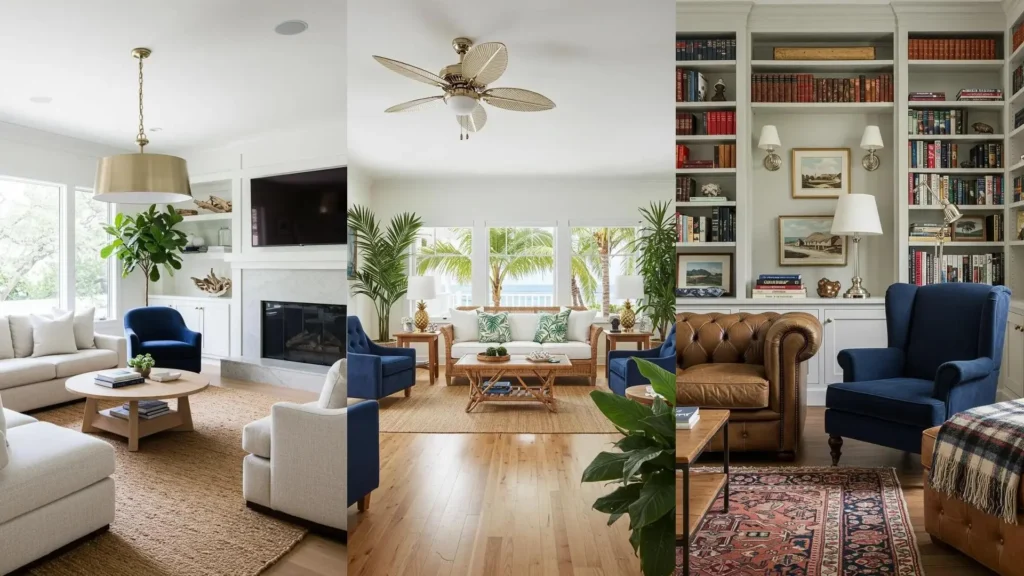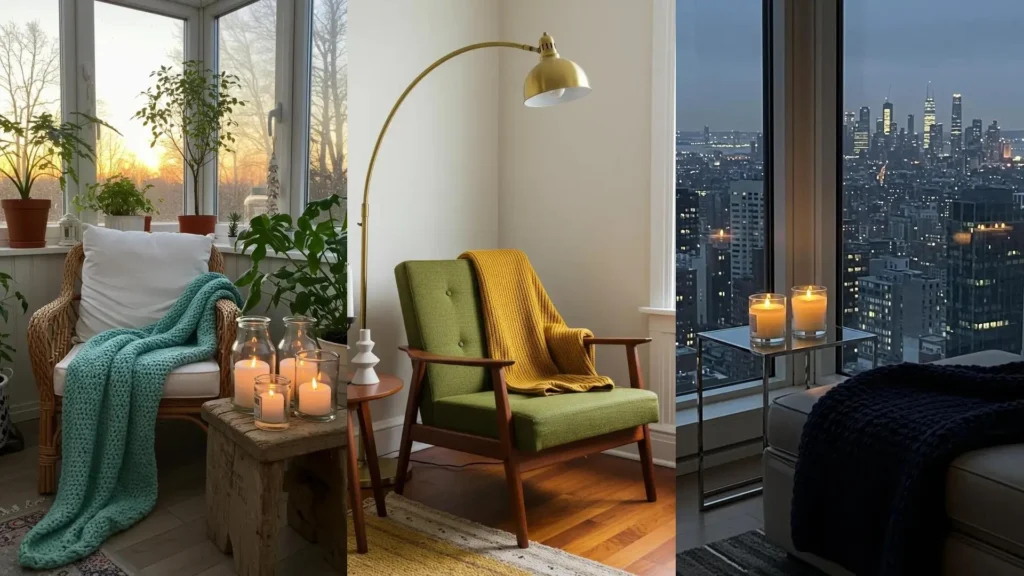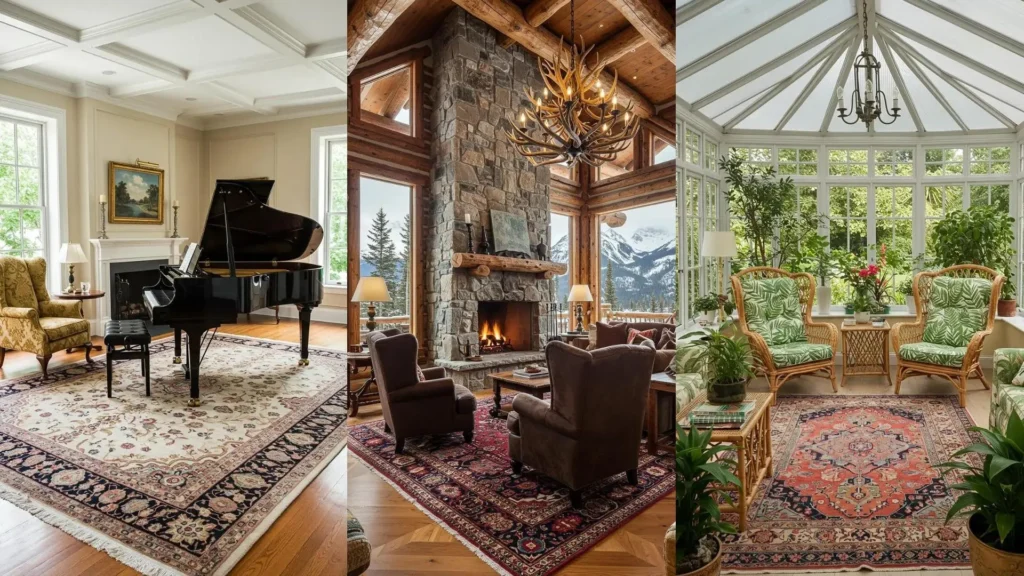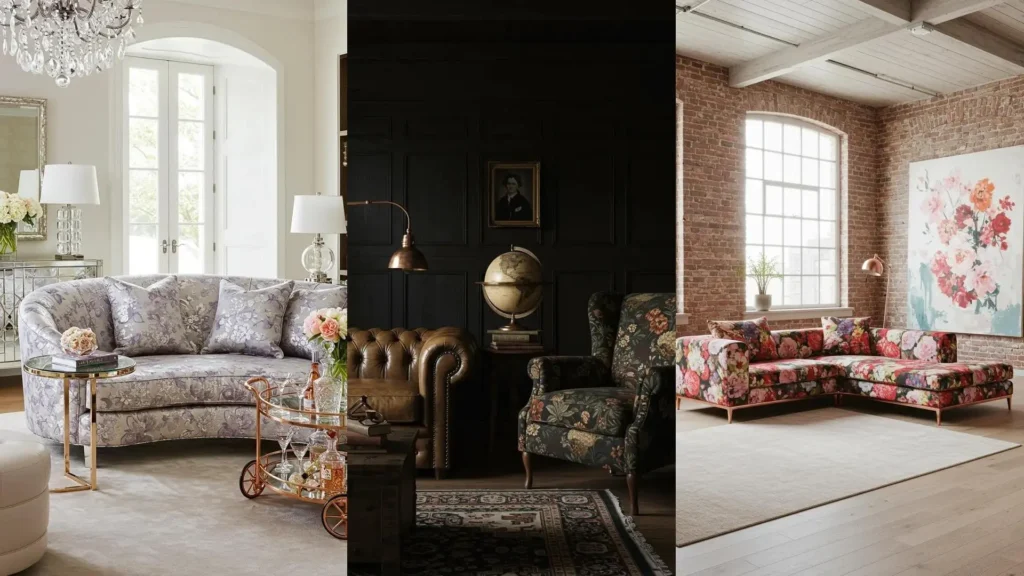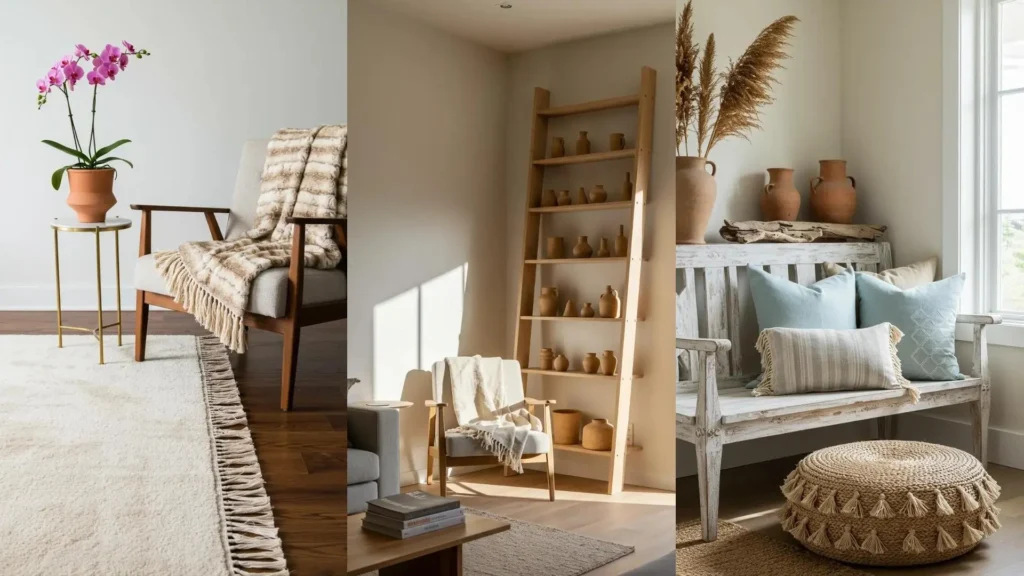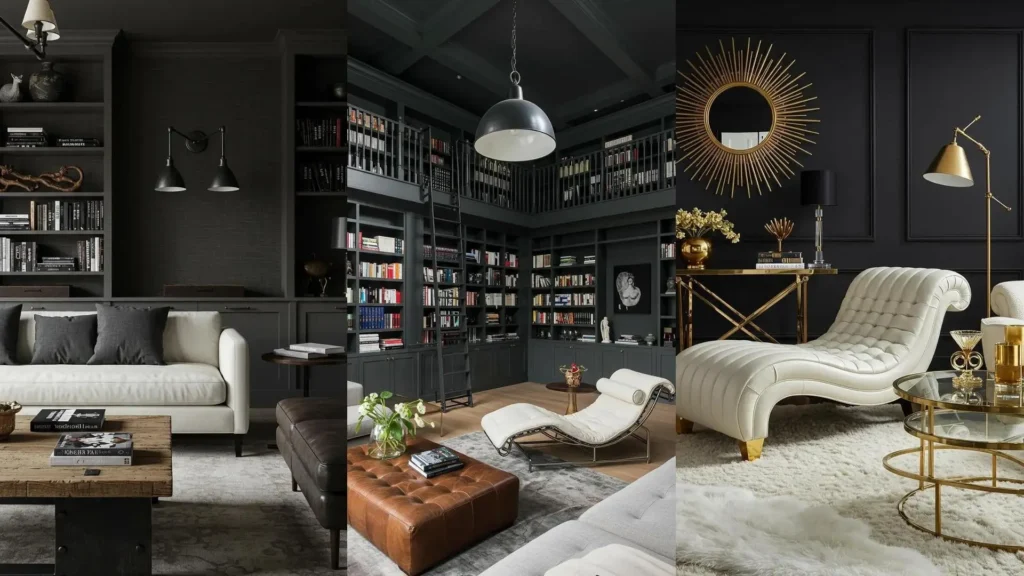Creating a truly peaceful living room isn’t about achieving an empty, sterile space. It’s about making deliberate choices that calm the eye and the mind, allowing you to feel genuinely at ease in your own home.
This is where the principles of Zen design, especially the use of low-profile furniture and the quiet presence of a bonsai tree, can be transformative. Lowering the sightlines with sofas and tables that sit closer to the ground instantly makes a room feel more open, grounded, and intimate.
Pairing this intentional layout with a single, sculptural bonsai introduces a living element of focus. It’s more than a houseplant; it’s a piece of living art that encourages a moment of pause. Let these ideas guide you toward creating a lounge that isn’t just beautiful, but deeply restorative.
1. Frame the Cityscape with Natural Forms
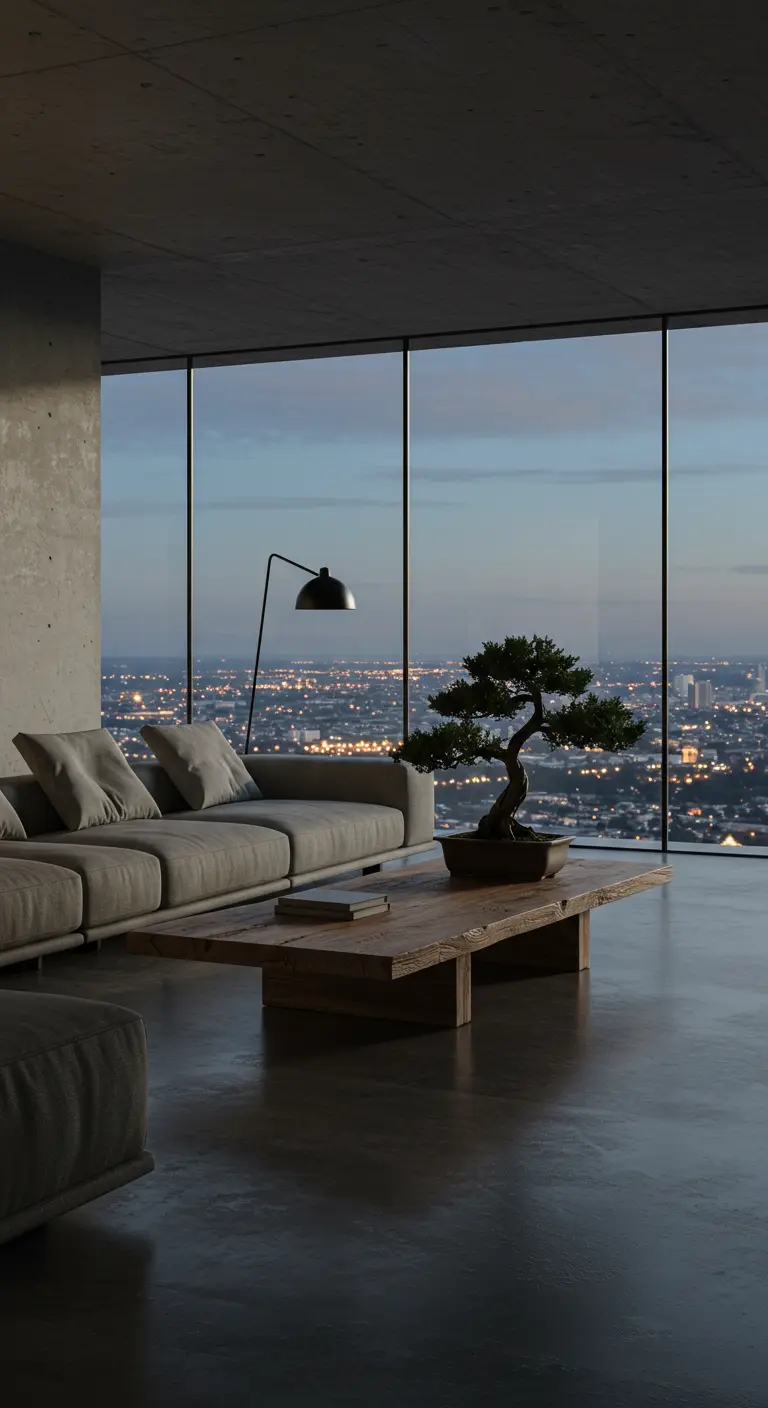
When your view is a sprawling urban landscape, create a calming counterpoint inside.
Place a low, substantial coffee table made of reclaimed wood in the foreground to serve as a natural anchor.
Top it with a carefully pruned bonsai; its organic, sculptural form provides a beautiful contrast to the geometric lines of the city skyline.
A single, arching floor lamp adds a soft glow without obstructing the view, drawing the eye inward as evening falls.
2. Define Zones with Tatami-Inspired Platforms
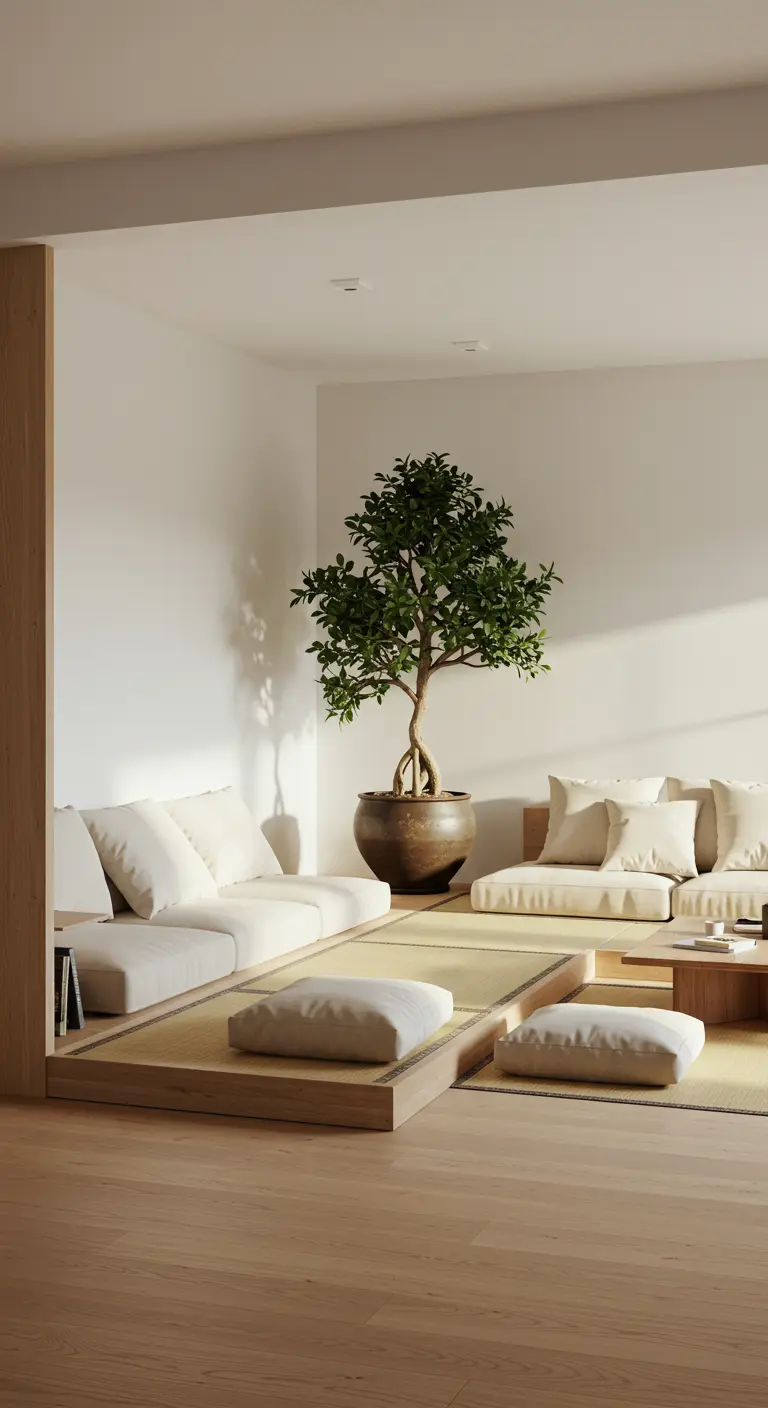
To create a truly serene lounge area, elevate your seating on a low, wood-framed platform.
This simple act defines the space with intention, separating it from the rest of the room and encouraging a slower, more mindful approach to relaxation.
Use tatami-style mats and unstructured floor cushions to invite comfortable, low-to-the-ground lounging.
A large, non-bonsai tree in a rustic pot can balance the strong horizontal lines, adding vertical interest and a touch of wildness to the structured space.
This approach borrows from Japandi interior ideas, blending calm with functional beauty.
3. Use a Single Color Pop as a Meditative Focus

In a neutral, monochromatic room, a single burst of vibrant color can have a powerful effect.
Choose a bonsai with striking foliage, like a Japanese Maple with deep red leaves, and make it the undeniable focal point.
Position it on a central table between two facing banquettes to create a symmetrical, balanced layout that feels inherently calm.
Use focused spotlights from the ceiling to illuminate the tree, transforming it into a piece of living art and drawing all attention to its form and color.
4. Echo the Outdoors with Color and Texture
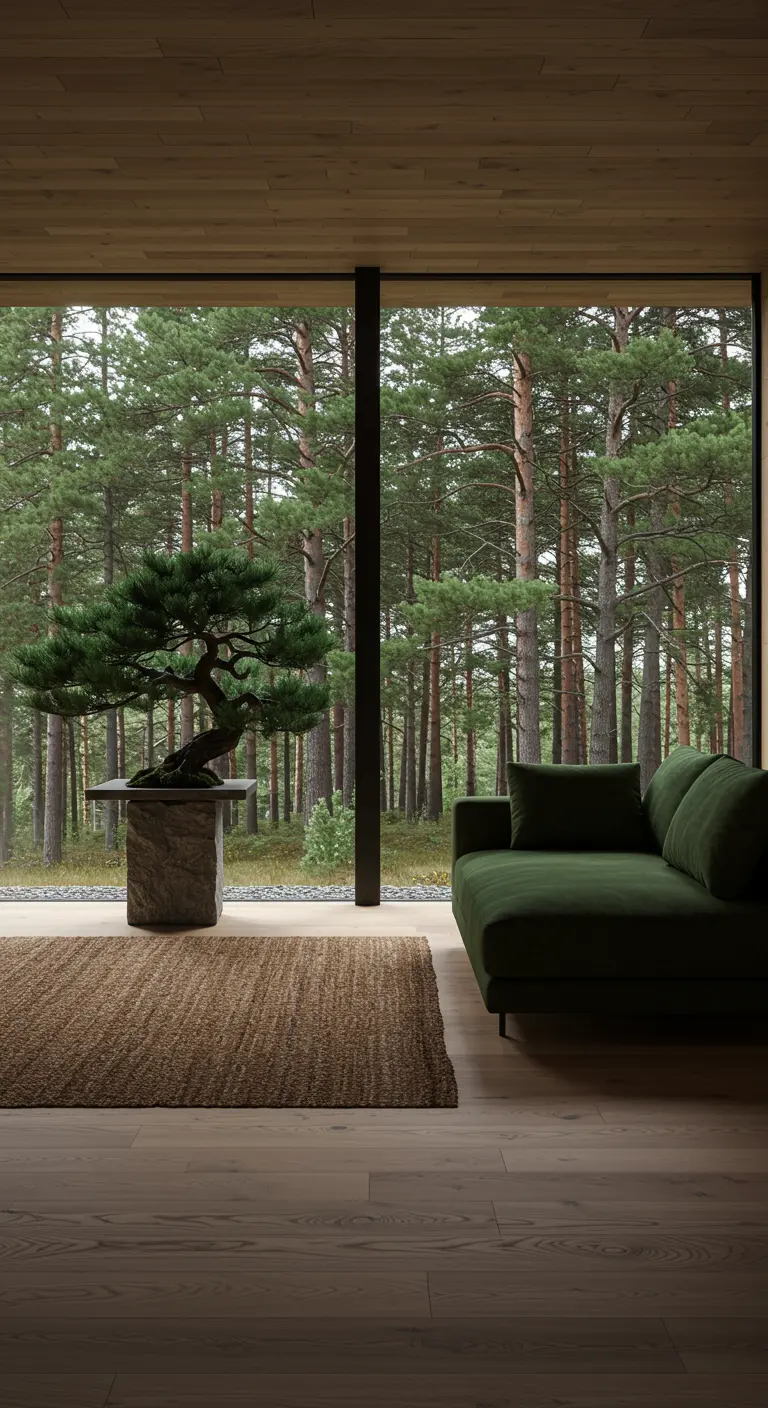
Create a seamless transition between your living space and a natural view by borrowing from nature’s palette.
If you overlook a forest, choose a sofa in a deep, mossy green velvet to pull that color indoors.
Ground the space with a heavily textured jute or sisal rug, which mimics the feeling of a forest floor.
Elevate a windswept bonsai on a pedestal of natural stone, making the connection to the rugged landscape outside even more direct.
5. Soften the Light for an Ethereal Feel
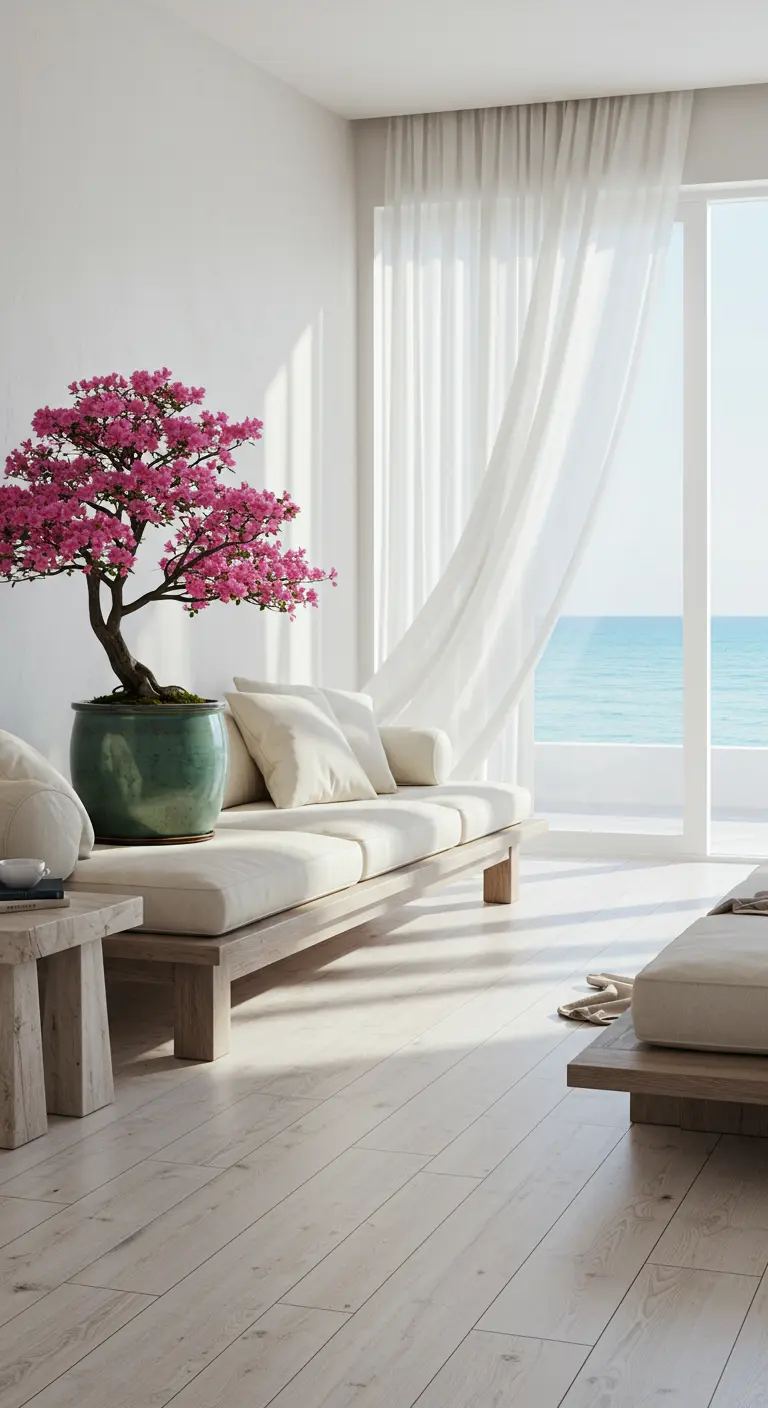
To capture a bright, coastal mood, prioritize soft, diffused light.
Hang long, sheer white curtains that billow gently, softening the sunlight and adding a touch of movement.
Keep furnishings light in both color and scale, using pale woods and off-white upholstery.
Introduce an unexpected touch of color with a flowering bonsai, like this pink azalea, placed in a glazed ceramic pot. It adds life and personality without overwhelming the coastal minimalism of the space.
6. Layer Earthy Tones for a Warm Embrace
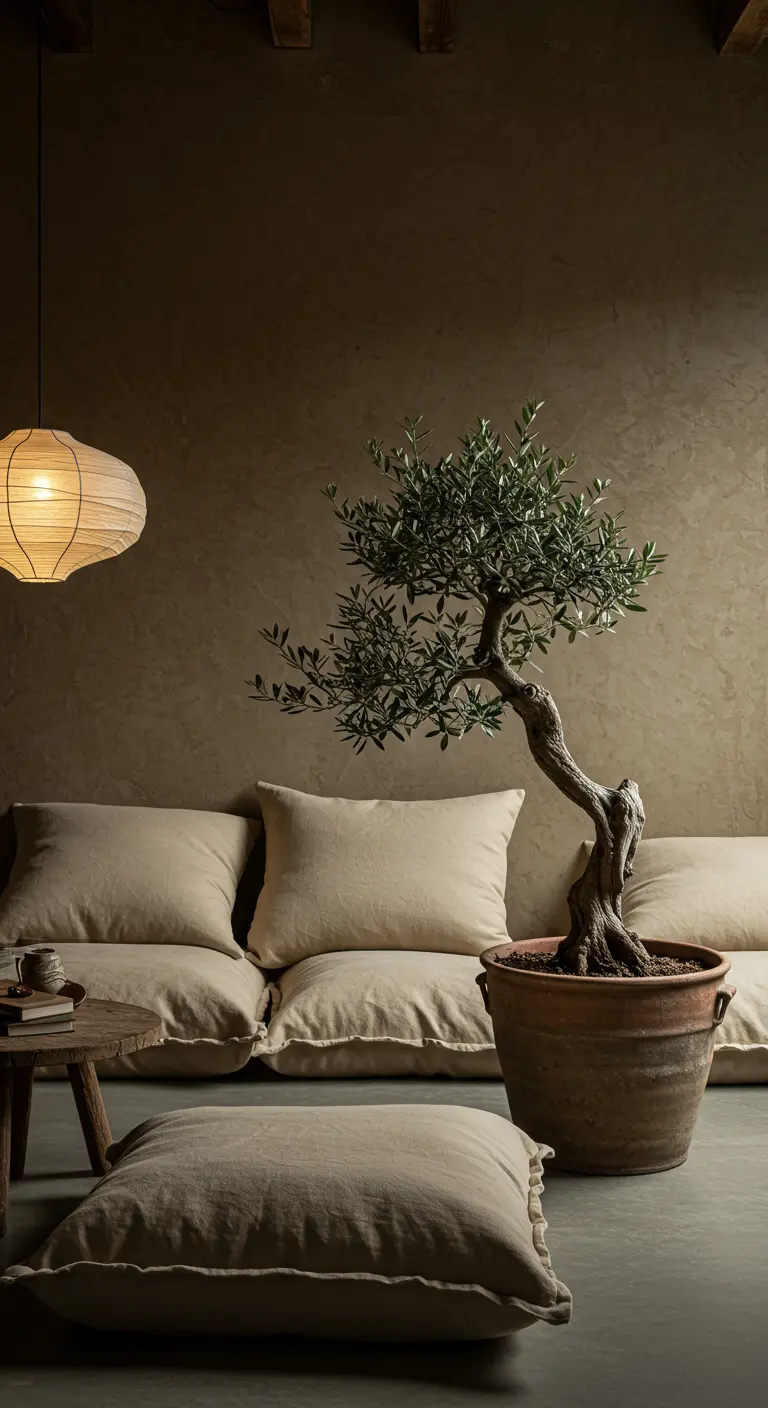
Create a room that feels like a warm, protective hug by layering various shades of beige, taupe, and terracotta.
Apply a textured finish like limewash or tadelakt to the walls to add depth and a soft, matte quality.
Choose unstructured, overstuffed linen cushions and low sofas for ultimate comfort.
A single paper lantern provides a gentle, ambient glow that enhances the room’s cocooning effect and complements the warm earth tones.
7. Elevate a Bonsai on a Floating Shelf
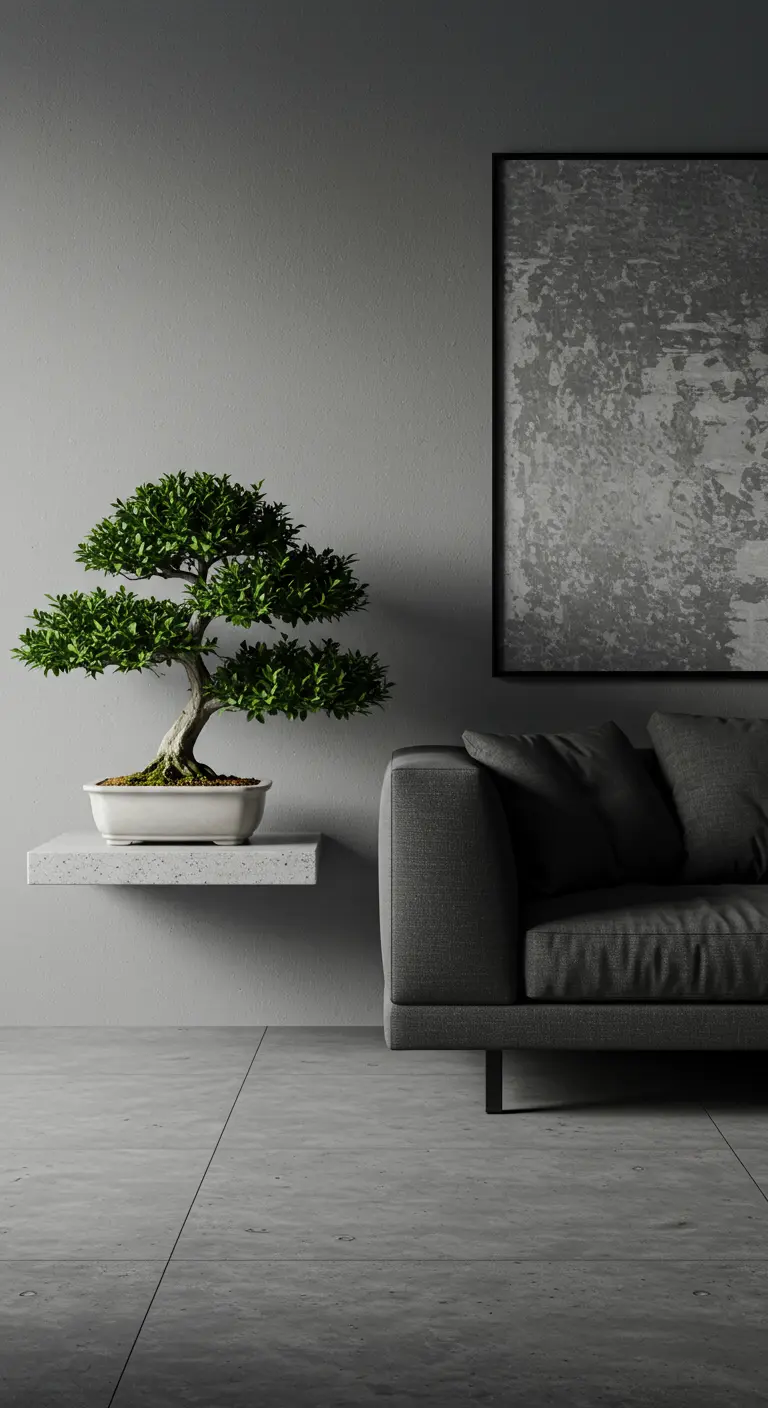
In a strictly minimalist space, every object must have purpose and presence.
Mount a thick, floating shelf to the wall to serve as a modern pedestal for your bonsai. This creates a clean, architectural display that makes the tree appear to hover.
This technique works especially well in elegant monochrome living rooms, as the lack of color focuses attention on the bonsai’s intricate shape.
Pair it with a single piece of large-scale, textural art to balance the composition without adding clutter.
8. Frame an Outdoor Garden as Living Art
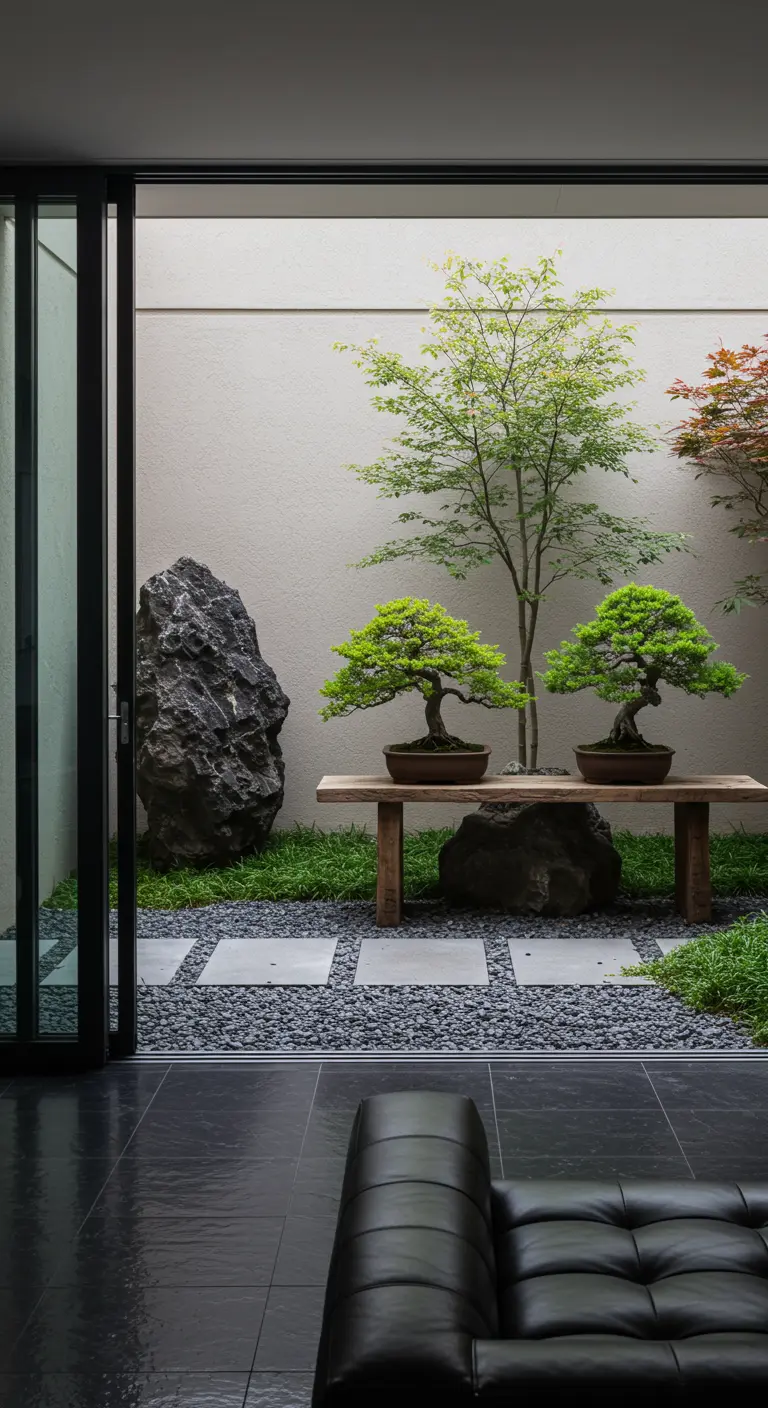
If you have an adjacent courtyard or patio, treat it as an extension of your living room.
Use a large sliding glass door to perfectly frame the view of an outdoor zen garden, effectively turning it into a dynamic piece of art.
Keep the interior furnishings minimal—a simple leather sofa is enough—so that the eye is naturally drawn outward.
This concept of “shakkei,” or borrowed scenery, is a core principle of Japanese design that creates a profound sense of peace and connection to nature.
You can even build your own zen garden feature to achieve this effect.
9. Contrast Industrial Loft and Organic Forms

Embrace the raw beauty of an industrial space by creating a deliberate contrast.
Leave elements like exposed brick walls, visible ductwork, and concrete floors untouched to retain the building’s character.
Then, introduce a large, powerful bonsai in a heavy concrete planter. Its gnarled, organic form stands in striking opposition to the rigid lines of the industrial architecture.
Soften the look with a comfortable, textured sofa in a neutral tone to make the space feel habitable and warm, proving that industrial fusion can be serene.
10. Create a Backdrop of Diffused Light

Use shoji-style screens or translucent panel blinds to create a wall of soft, filtered light.
This technique obscures any distracting outdoor views and provides the perfect, serene backdrop for highlighting a delicate silhouette.
Place a single, sparsely-leafed bonsai on a low table in front of the screen. The backlighting will emphasize its intricate branch structure.
Arrange simple floor cushions around the table to encourage quiet contemplation, creating one of those cozy corners perfect for reflection.
11. Sculpt with Architectural Lighting
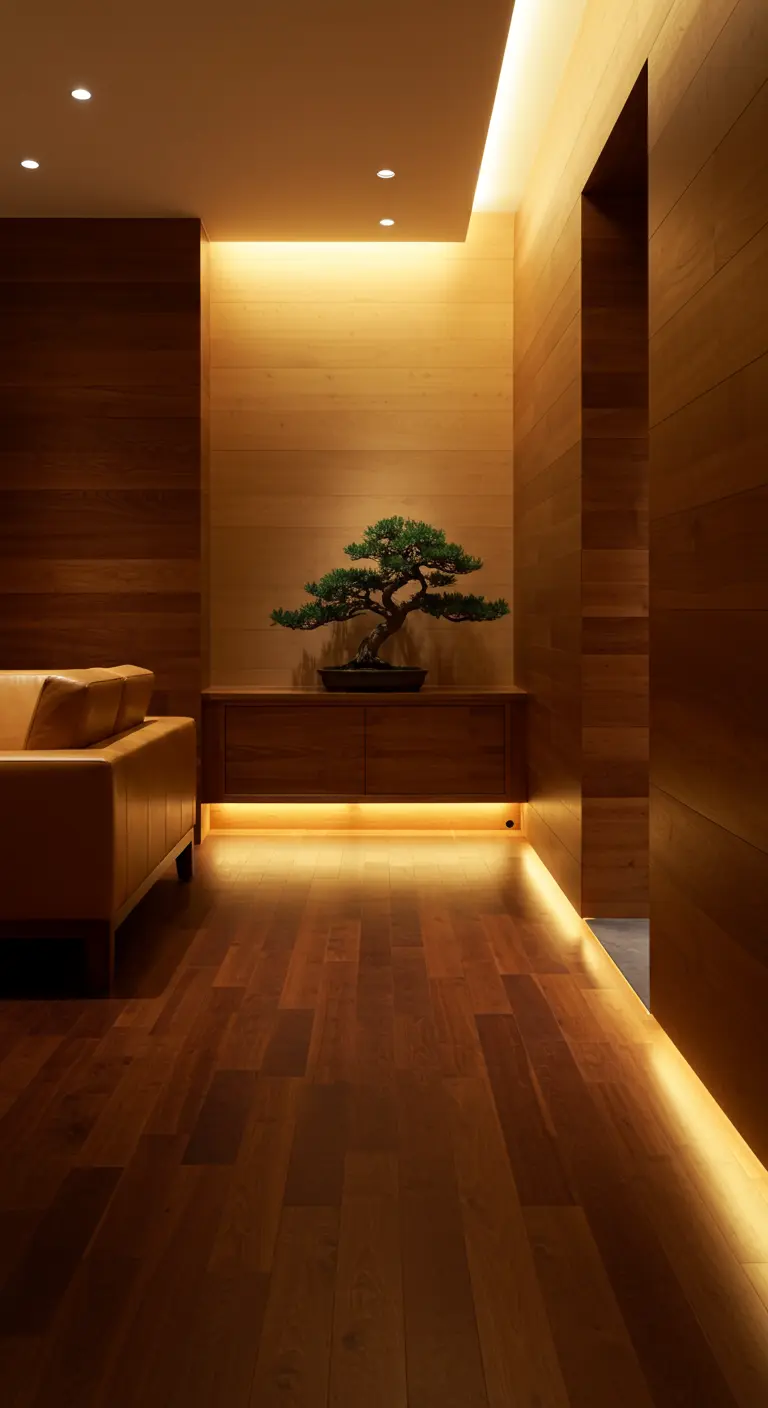
Think of lighting as a design tool, not just an afterthought.
In a room paneled with warm wood, install hidden LED strips along the floor and in ceiling coves.
This indirect lighting technique, known as wall grazing, accentuates the texture of the wood and creates a warm, encompassing glow without any harsh glare.
Place your bonsai on a console where it will be lit from below, giving it a dramatic, gallery-like presence. These refined contemporary rooms rely on such smart details.
12. Embrace Raw, Found-Object Textures

Invite the untamed beauty of the natural world inside by using found objects as furniture.
Instead of a conventional side table, use a raw tree stump or a weathered log. Its rugged texture and imperfect form add character and a sense of history.
Pair it with other desert-inspired interiors elements like a large olive bonsai in a sand-colored pot and a nubby, bouclé sofa.
This approach celebrates the beauty of imperfection and creates a space that feels deeply connected to the earth.
13. Use Symmetry for a Sense of Order
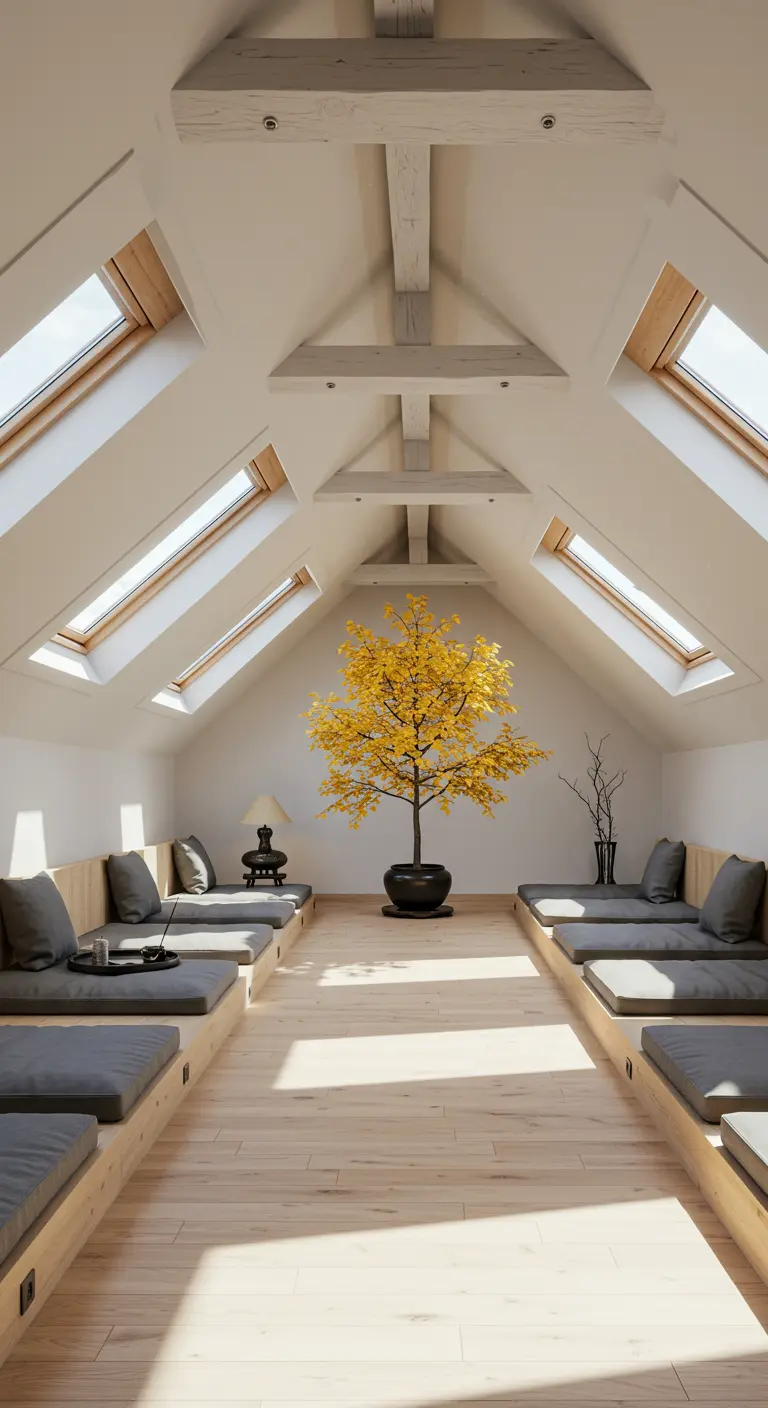
In a long, narrow room or an attic space with strong architectural lines, symmetry is your most powerful tool for creating calm.
Arrange identical built-in banquettes or low sofas along the two longest walls to create a clear, balanced pathway.
Place a single, stunning focal point—like this vibrant yellow ginkgo bonsai—at the very center of the room’s far end.
The human brain is wired to find symmetry pleasing and restful, making this layout feel instantly serene and organized.
14. Integrate Shelving with Architectural Features

Make your storage feel intentional and light by integrating it with your room’s architecture.
Here, two floating wood shelves extend from the fireplace structure, creating an asymmetrical design that feels balanced yet dynamic.
This prevents the wall from feeling heavy and provides the perfect, understated platform for a bonsai, books, and a few ceramic pieces.
The natural wood of the shelves warms up the white walls and connects to the oak flooring.
15. Engage the Senses with Sound and Texture
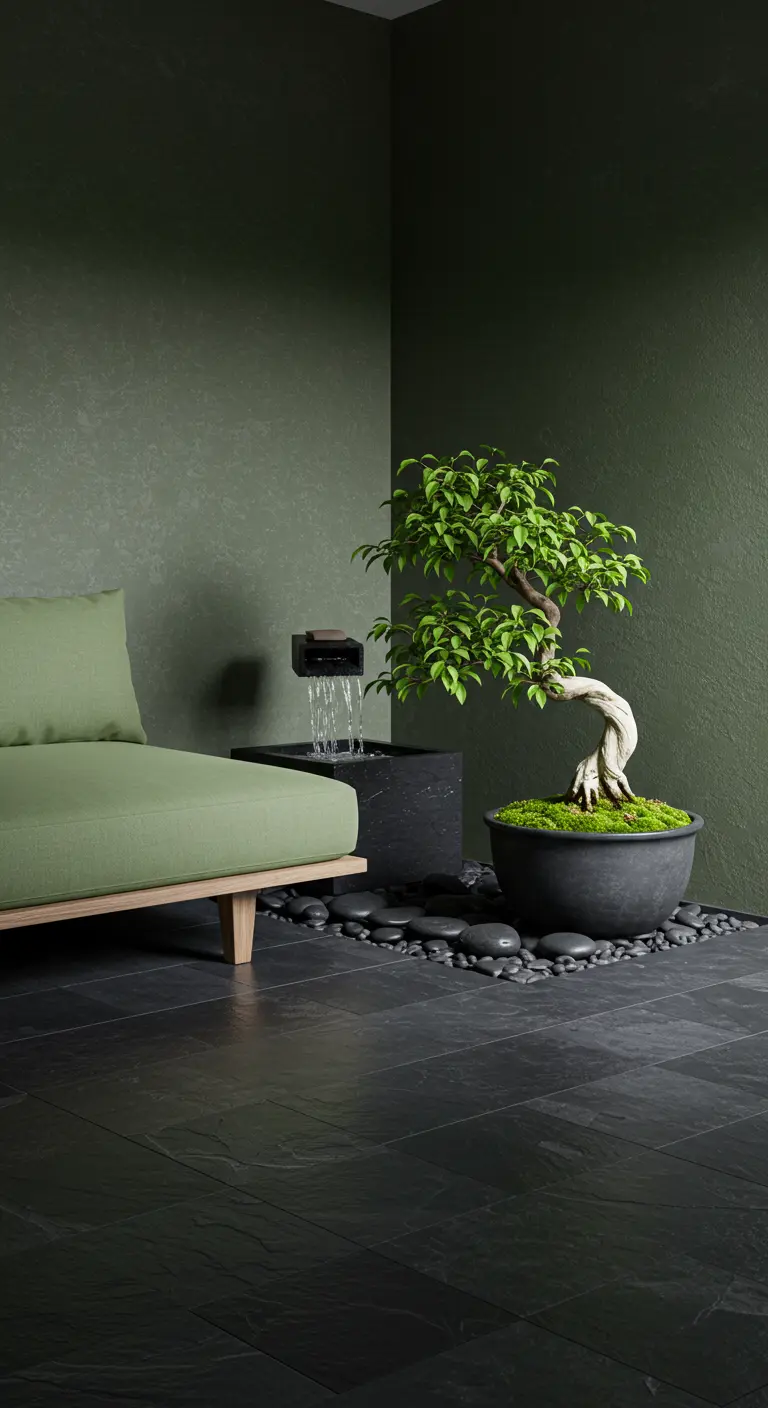
A truly Zen space engages more than just the eyes. Introduce the element of sound with a small, minimalist water feature.
The gentle sound of trickling water is inherently calming and helps to mask distracting background noise.
Place it next to your bonsai on a bed of smooth river stones, which adds another layer of natural texture.
Set this scene against a dark, moody wall in a deep olive or charcoal to create a contemplative corner that encourages you to pause.
16. Ground the Room with a Stone Table
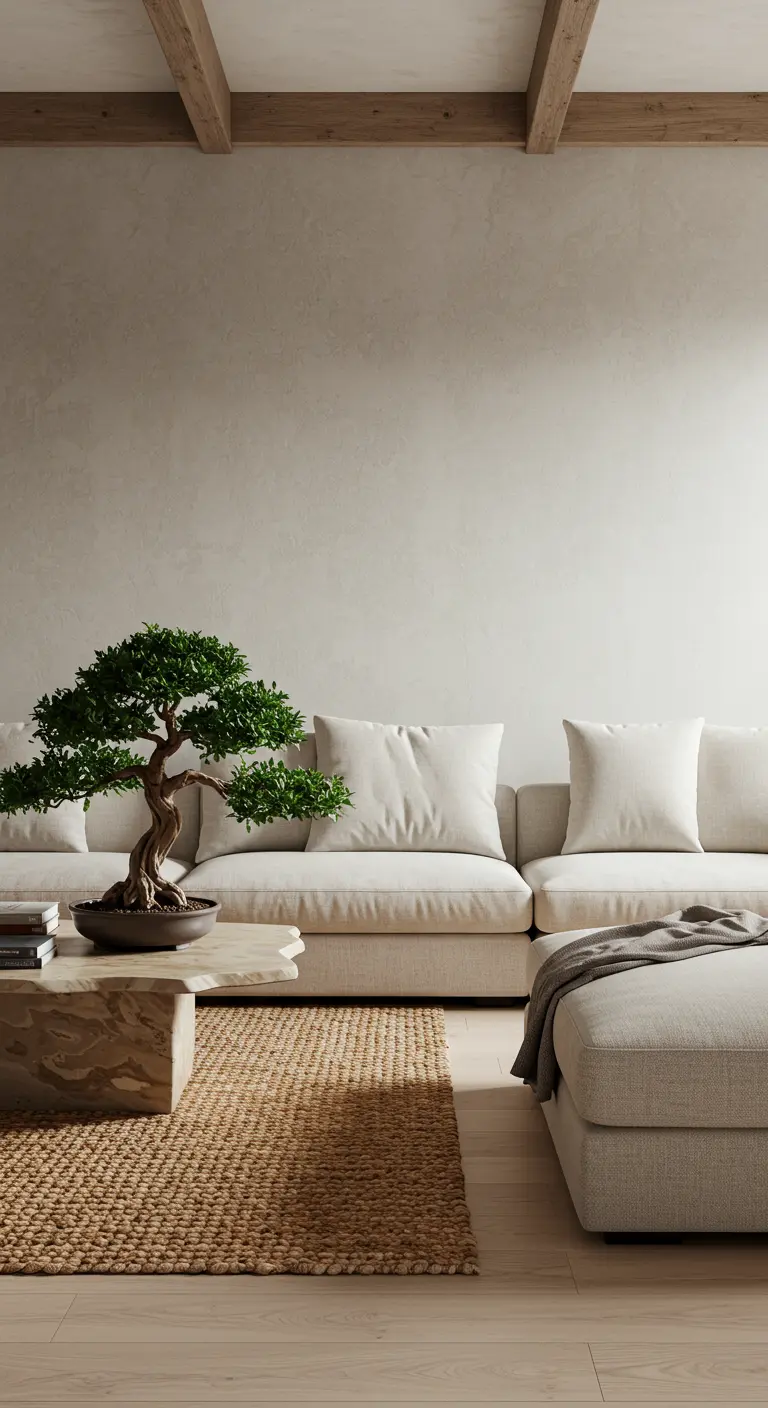
To prevent a light-colored room from feeling like it might float away, you need an anchor.
A coffee table carved from a single block of travertine or marble introduces a powerful sense of permanence and gravity.
Its cool, smooth surface provides a wonderful textural contrast to a soft, woven jute rug and plush linen sofa.
This combination of hard and soft, smooth and rough, is what gives a neutral space its depth and sophistication, much like in these elegant neutral palettes.
17. Position a Bonsai to Capture the Sunset
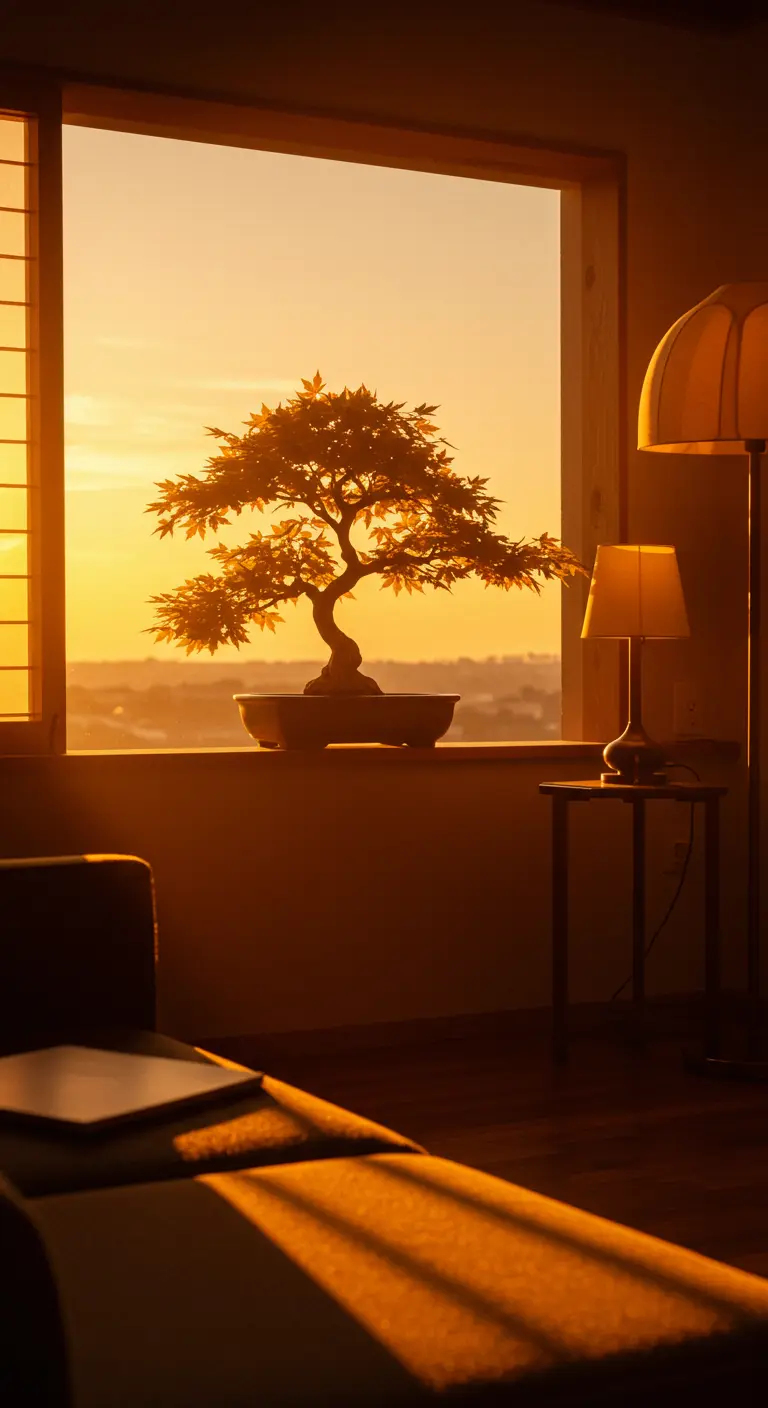
Think about how natural light moves through your space during the day, especially during the golden hour before sunset.
Place your bonsai on a windowsill or table where it will be backlit by the setting sun.
The warm, low-angled light will set its leaves ablaze with color and cast long, dramatic shadows into the room.
This simple act of positioning transforms the tree into a dynamic element that changes with the light, connecting your indoor space to the daily rhythm of nature.
18. Create a High-Contrast Gallery Feel
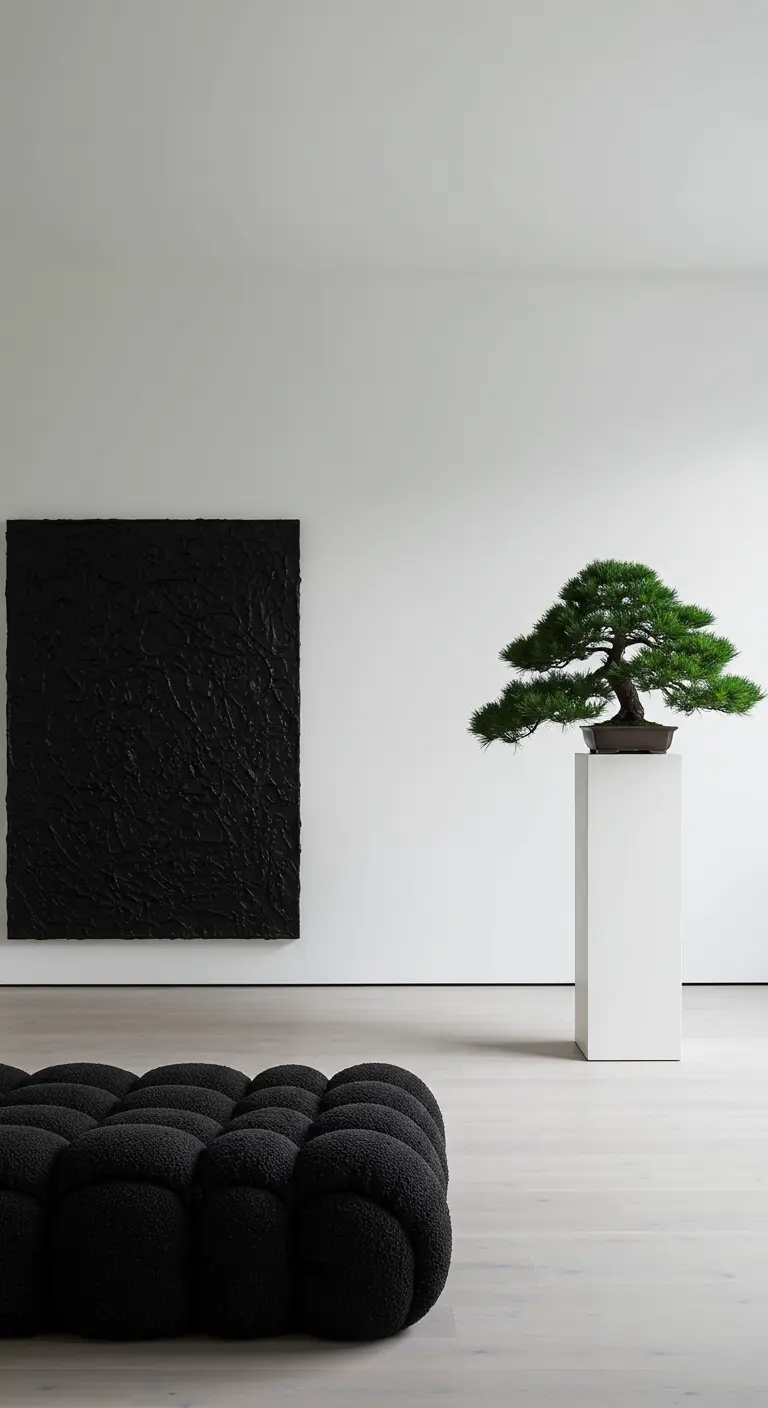
For a bold, dramatic take on minimalism, pare your room back to two essential colors: black and white.
Treat your walls as a blank canvas and your furniture as sculpture. Here, a heavily textured black painting and a tufted black bouclé seat make strong statements.
Place a windswept pine bonsai on a clean, white pedestal. In this high-contrast environment, it is no longer just a plant; it becomes the primary work of art in your personal gallery.
The key is an abundance of negative space, which allows each piece to be appreciated individually.
19. Soften Geometry with Curves
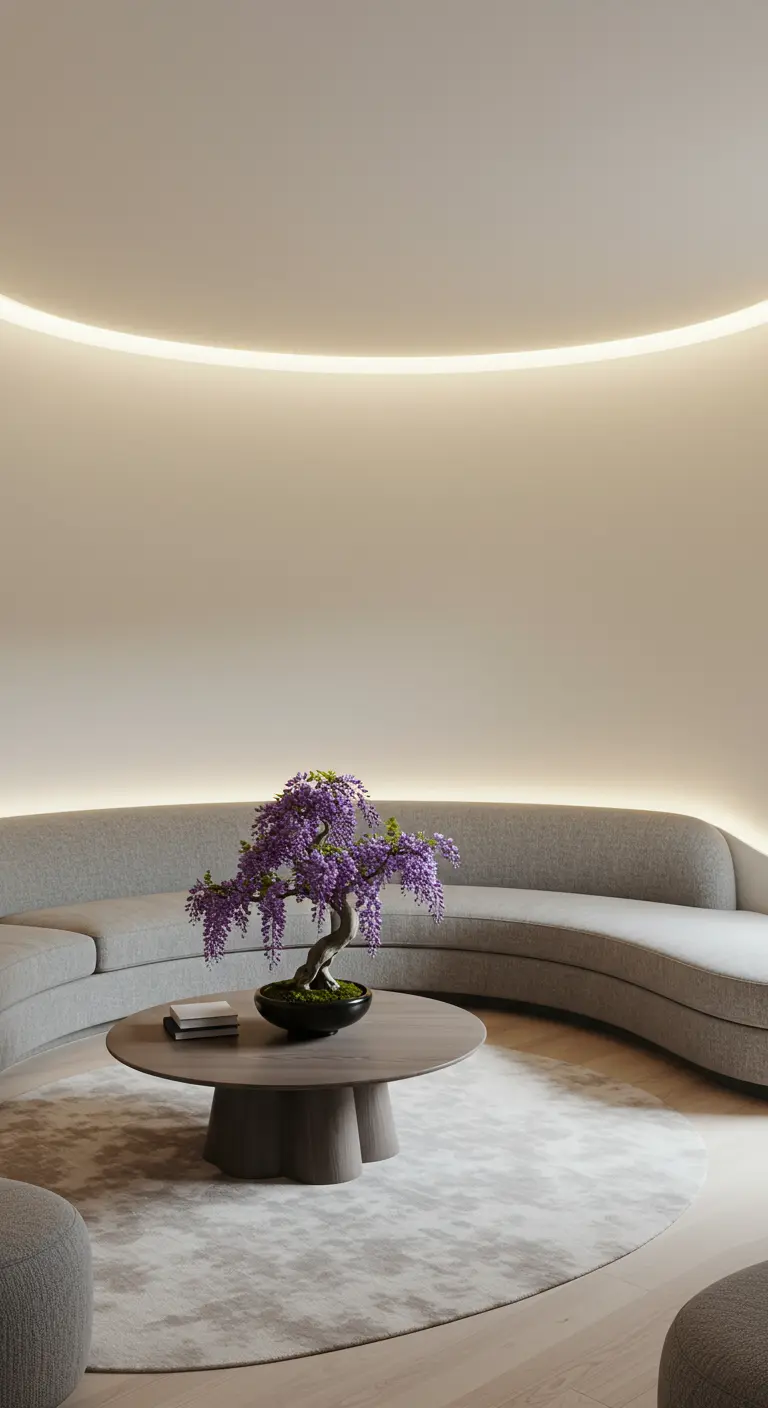
To create a space that feels nurturing and inviting, move away from sharp angles and embrace curves.
A long, curved sofa encourages conversation by gently turning its occupants toward one another.
Define the seating area with a large, round rug that mirrors the sofa’s shape.
Hidden cove lighting that follows the curve of the wall adds a soft, uniform glow, enhancing the room’s gentle, circular flow. It’s a key feature in many transitional classic-modern living spaces.
20. Make the Coffee Table a Zen Garden
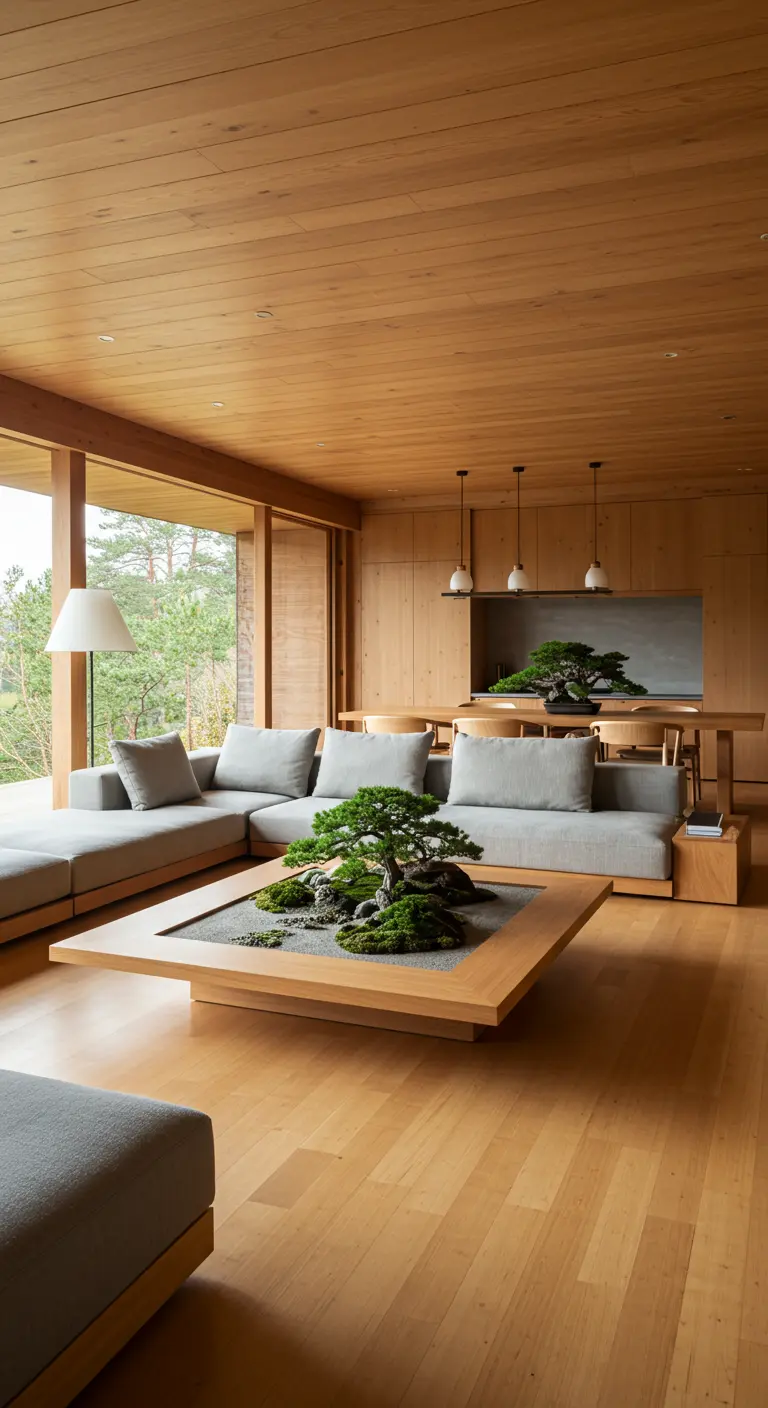
Turn your coffee table into the meditative heart of the room by transforming it into a miniature landscape.
Design or choose a table with a recessed center that you can fill with sand, gravel, and moss.
Plant a bonsai directly within this landscape to create an integrated, living centerpiece.
This brings the principles of a full-scale Japanese garden into your home in a contained, accessible way, offering a constant invitation to pause and reflect.
21. Marry Interior Stone with an Alpine View
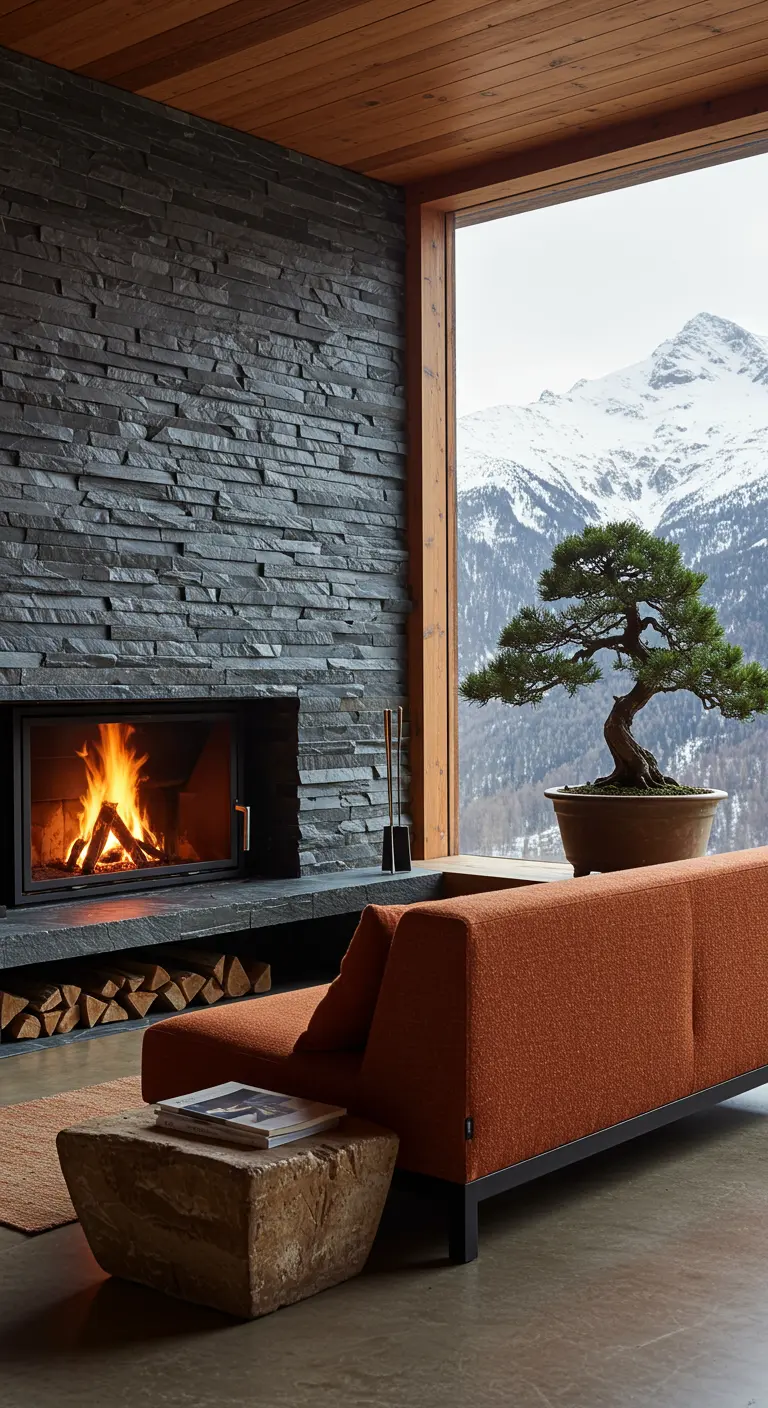
Create an undeniable link between your home and its environment by using materials that mirror the landscape.
If your view is of rugged mountains, construct a feature wall from stacked slate or ledger stone.
The texture, color, and horizontal lines of the stone will directly echo the rock formations outside, blurring the boundary between indoors and out.
An orange bouclé sofa adds a surprising-yet-welcome pop of warm color against the cool stone and snowy vista, a hallmark of cozy Scandinavian winter retreats.
22. Master the Art of Tranquil Simplicity
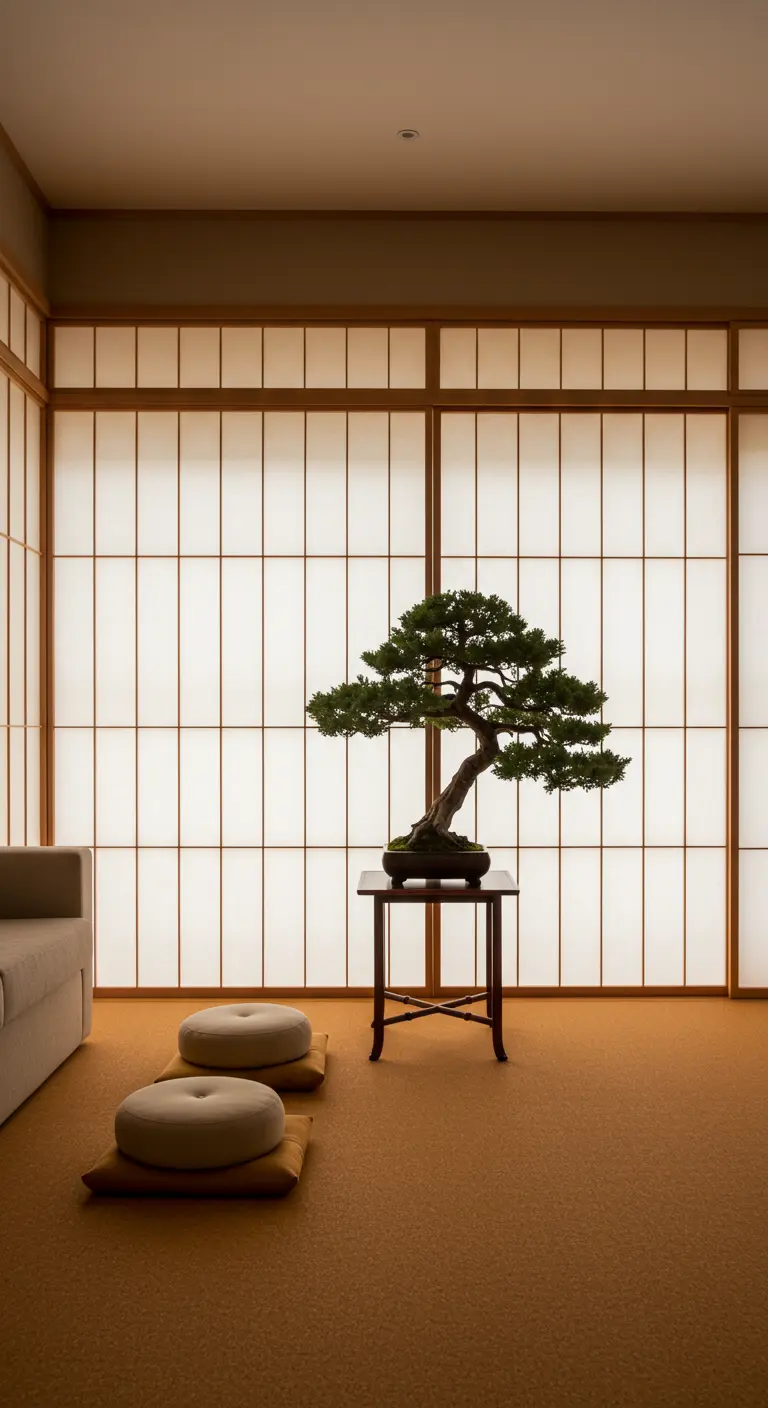
Sometimes the most calming space is the most simple. Embrace traditional Japanese aesthetics for a room devoted to peace.
Use shoji screen doors to create a wall of geometric, filtered light.
Opt for cork or tatami flooring, which is soft and warm underfoot.
Furnish the space with only the essentials: a few comfortable floor cushions (zabuton) and a single, elegant table to hold a perfectly shaped bonsai. This is the essence of contemporary Zen living.
23. Pair Rich Jewel Tones with Polished Brass
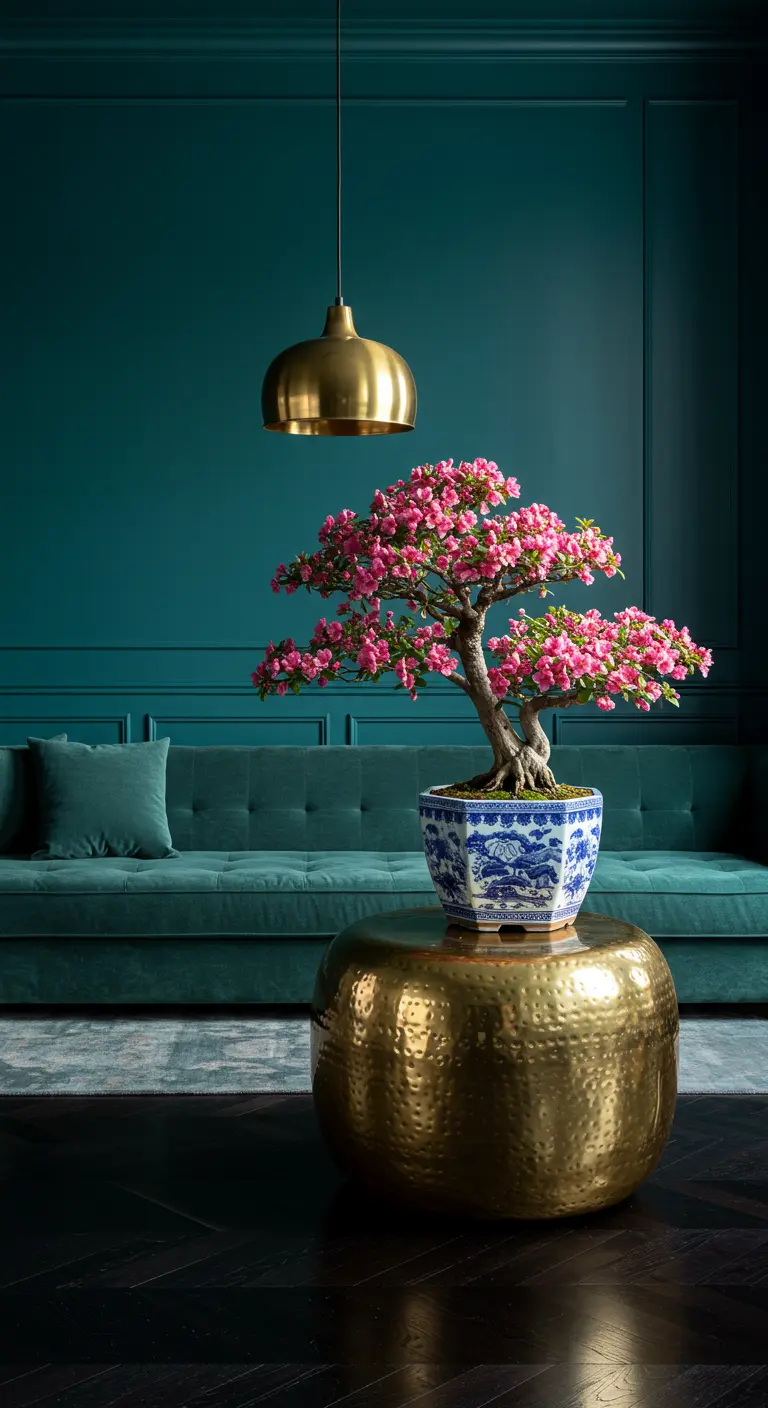
Zen-inspired design doesn’t have to be neutral. For a touch of glamour, embrace deep, moody color.
Paint your walls in a rich, saturated jewel tone like emerald or deep teal, including the trim for a fully immersive effect.
Introduce warmth and light by adding polished brass accents, such as a hammered metal side table and a sleek pendant lamp.
The combination is dramatic and sophisticated, providing a stunning backdrop for a flowering bonsai in a contrasting porcelain pot. It’s a look that feels both bold and intentional, much like you’d find in bold jewel-tone balcony corners.
24. Celebrate the Power of Negative Space
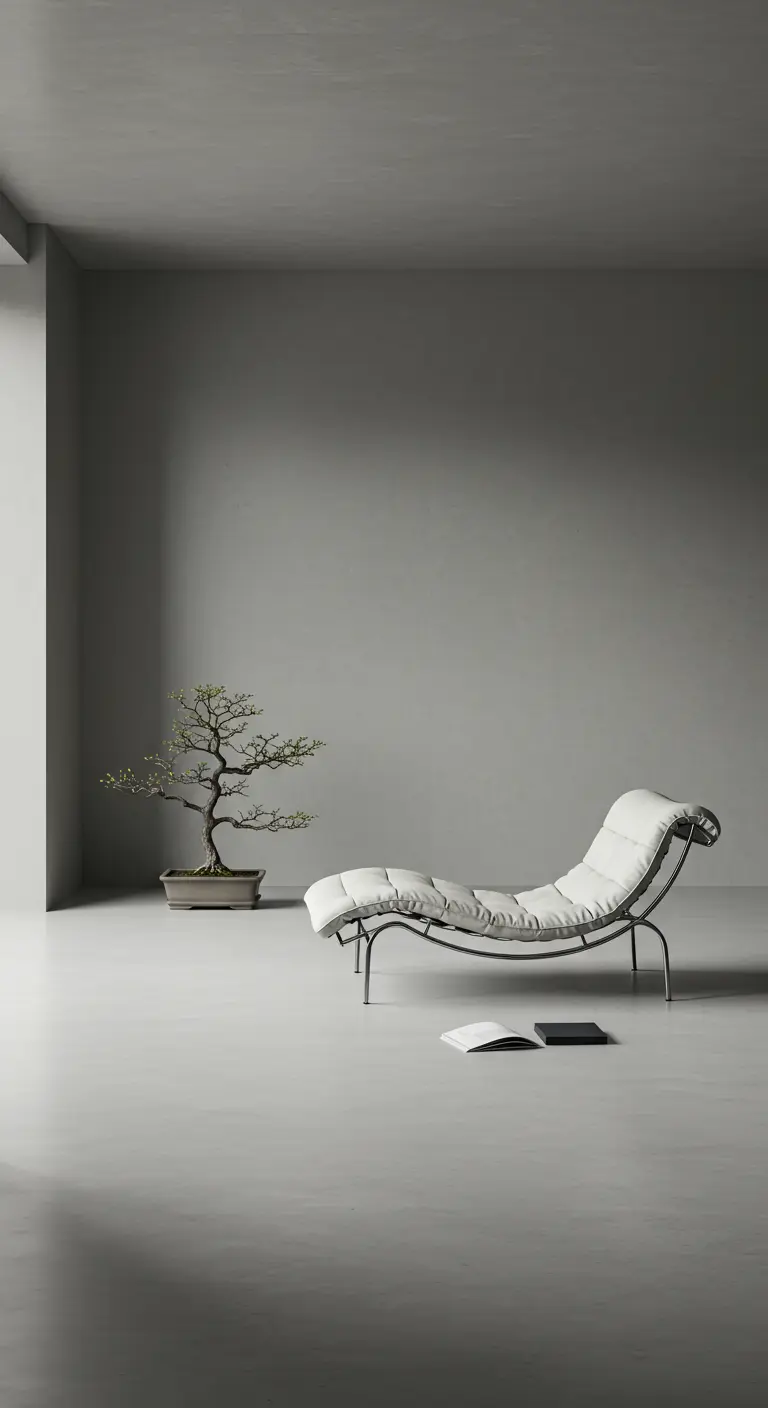
To create a space for quiet thought, focus on what you can take away, not what you can add.
In a room with uniform, neutral-toned walls and floors, every object gains importance.
Place a single, beautifully designed chaise lounge—an object for pure relaxation—and a delicate bonsai in the corner.
The empty space around them is not wasted; it’s an active component of the design, allowing your mind to rest and your eye to focus without distraction.
25. Blend Zen Calm with Tropical Warmth
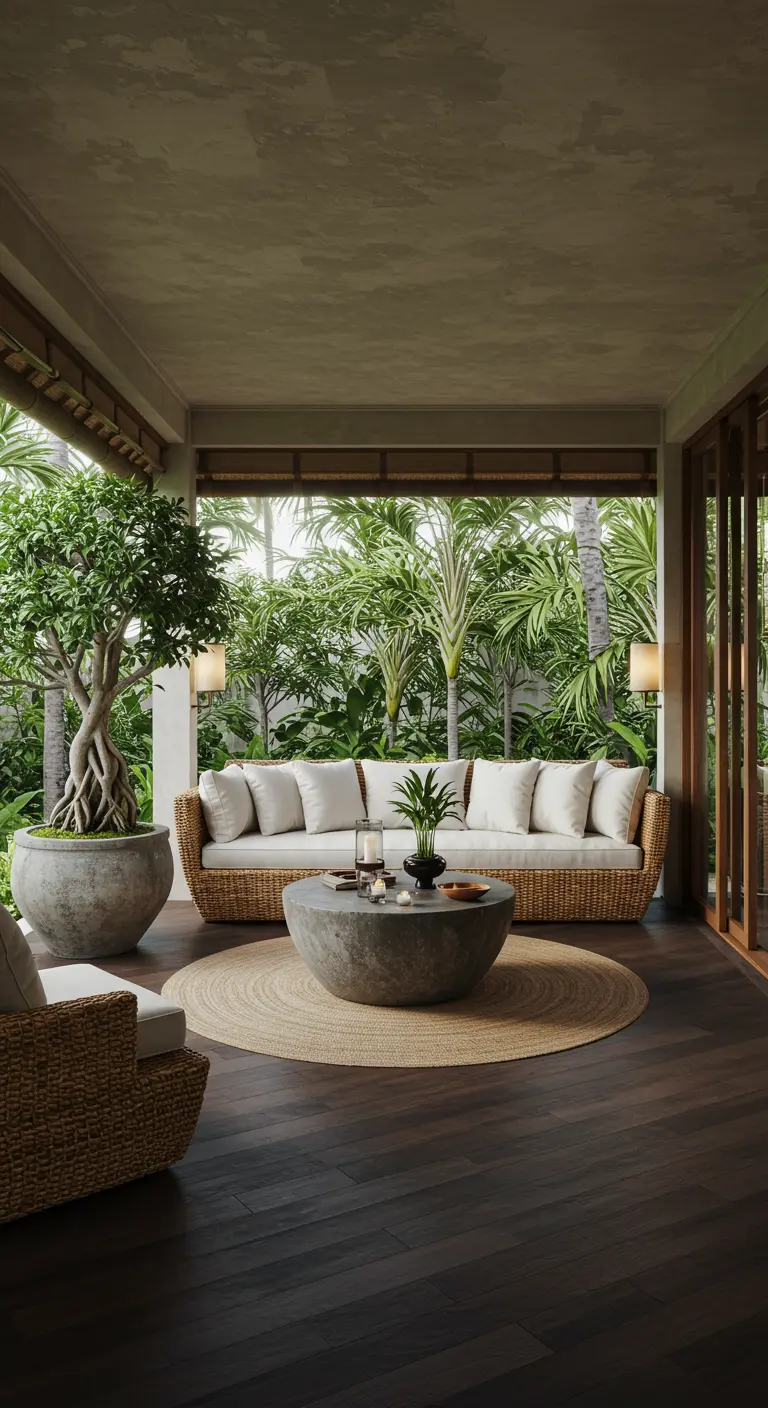
Create the feeling of a luxurious resort by merging the tranquility of Zen design with the warmth of tropical style.
Use natural, woven materials like rattan or water hyacinth for your sofa and chairs to add texture and a relaxed vibe.
Anchor the space with a round jute rug and a heavy, stone-like coffee table.
Surround the area with lush greenery, including a large, sculptural bonsai in a rustic pot, to create your own tropical oasis that feels both peaceful and alive.
26. Infuse Scandinavian Design with a Zen Touch
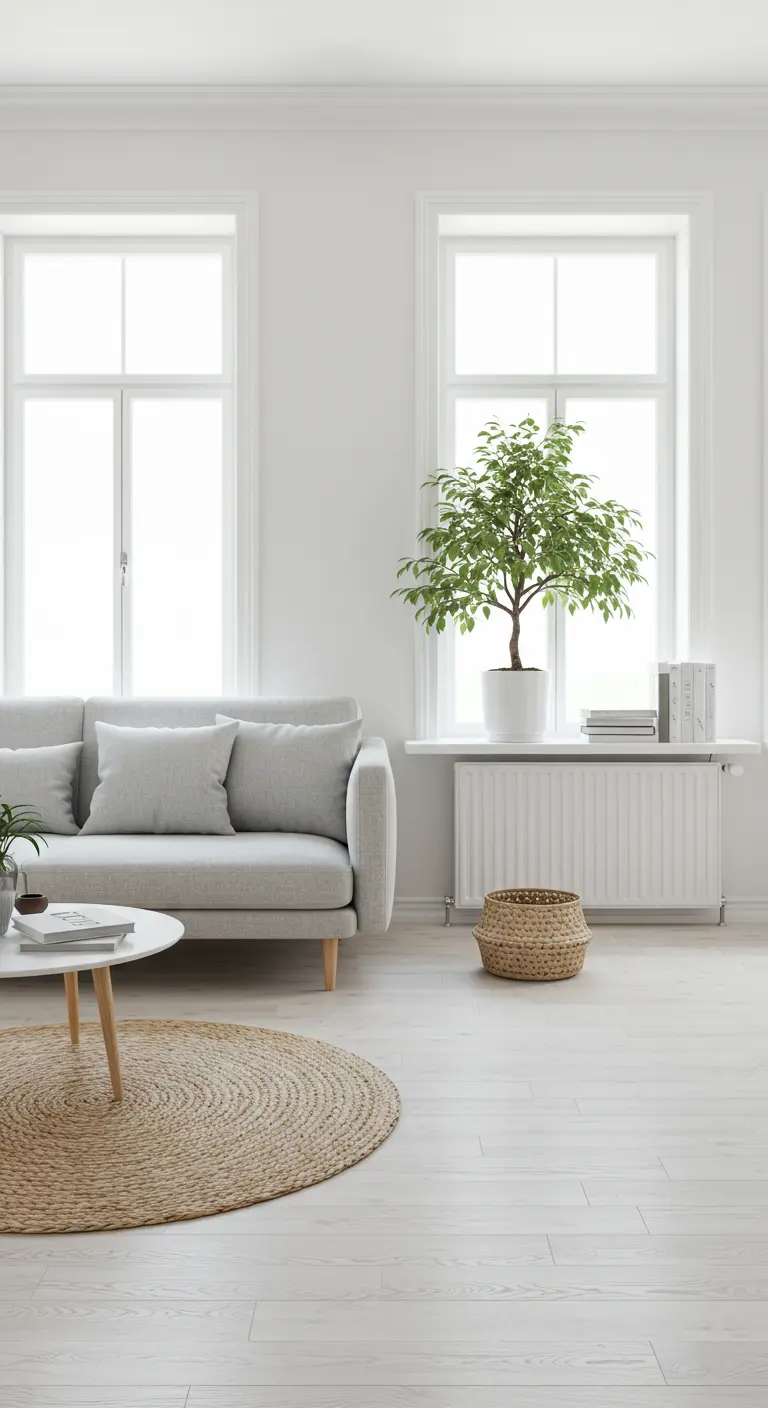
The core principles of Scandinavian and Zen design—simplicity, natural materials, and light—are natural partners.
Start with a classic Scandi base: light wood floors, white walls, and a comfortable gray sofa with clean lines.
Introduce a bonsai as your primary piece of decor. Its organic, sculptural form adds a touch of complexity and mindfulness that elevates the minimalist aesthetic.
A round jute rug and a woven basket add texture, keeping the space warm and inviting. It’s a hallmark of bright, hygge-inspired dining rooms and lounges.
